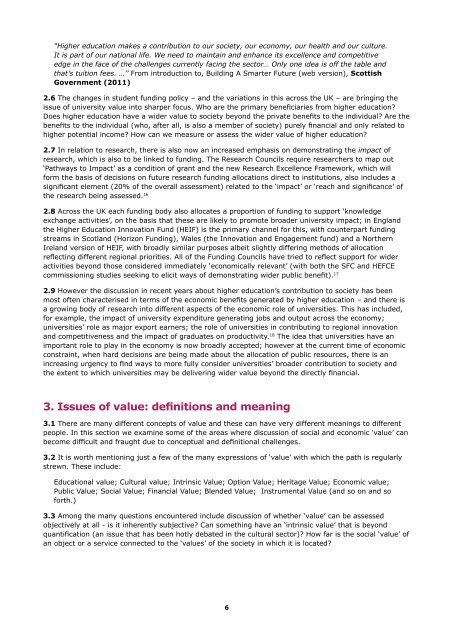Through a glass darkly Measuring the social value of universities
80096 NCCPE Social Value Report (2)
80096 NCCPE Social Value Report (2)
- No tags were found...
Create successful ePaper yourself
Turn your PDF publications into a flip-book with our unique Google optimized e-Paper software.
“Higher education makes a contribution to our society, our economy, our health and our culture.It is part <strong>of</strong> our national life. We need to maintain and enhance its excellence and competitiveedge in <strong>the</strong> face <strong>of</strong> <strong>the</strong> challenges currently facing <strong>the</strong> sector… Only one idea is <strong>of</strong>f <strong>the</strong> table andthat’s tuition fees. …’’ From introduction to, Building A Smarter Future (web version), ScottishGovernment (2011)2.6 The changes in student funding policy – and <strong>the</strong> variations in this across <strong>the</strong> UK – are bringing <strong>the</strong>issue <strong>of</strong> university <strong>value</strong> into sharper focus. Who are <strong>the</strong> primary beneficiaries from higher education?Does higher education have a wider <strong>value</strong> to society beyond <strong>the</strong> private benefits to <strong>the</strong> individual? Are <strong>the</strong>benefits to <strong>the</strong> individual (who, after all, is also a member <strong>of</strong> society) purely financial and only related tohigher potential income? How can we measure or assess <strong>the</strong> wider <strong>value</strong> <strong>of</strong> higher education?2.7 In relation to research, <strong>the</strong>re is also now an increased emphasis on demonstrating <strong>the</strong> impact <strong>of</strong>research, which is also to be linked to funding. The Research Councils require researchers to map out‘Pathways to Impact’ as a condition <strong>of</strong> grant and <strong>the</strong> new Research Excellence Framework, which willform <strong>the</strong> basis <strong>of</strong> decisions on future research funding allocations direct to institutions, also includes asignificant element (20% <strong>of</strong> <strong>the</strong> overall assessment) related to <strong>the</strong> ‘impact’ or ‘reach and significance’ <strong>of</strong><strong>the</strong> research being assessed. 162.8 Across <strong>the</strong> UK each funding body also allocates a proportion <strong>of</strong> funding to support ‘knowledgeexchange activities’, on <strong>the</strong> basis that <strong>the</strong>se are likely to promote broader university impact; in England<strong>the</strong> Higher Education Innovation Fund (HEIF) is <strong>the</strong> primary channel for this, with counterpart fundingstreams in Scotland (Horizon Funding), Wales (<strong>the</strong> Innovation and Engagement fund) and a Nor<strong>the</strong>rnIreland version <strong>of</strong> HEIF, with broadly similar purposes albeit slightly differing methods <strong>of</strong> allocationreflecting different regional priorities. All <strong>of</strong> <strong>the</strong> Funding Councils have tried to reflect support for wideractivities beyond those considered immediately ‘economically relevant’ (with both <strong>the</strong> SFC and HEFCEcommissioning studies seeking to elicit ways <strong>of</strong> demonstrating wider public benefit). 172.9 However <strong>the</strong> discussion in recent years about higher education’s contribution to society has beenmost <strong>of</strong>ten characterised in terms <strong>of</strong> <strong>the</strong> economic benefits generated by higher education – and <strong>the</strong>re isa growing body <strong>of</strong> research into different aspects <strong>of</strong> <strong>the</strong> economic role <strong>of</strong> <strong>universities</strong>. This has included,for example, <strong>the</strong> impact <strong>of</strong> university expenditure generating jobs and output across <strong>the</strong> economy;<strong>universities</strong>’ role as major export earners; <strong>the</strong> role <strong>of</strong> <strong>universities</strong> in contributing to regional innovationand competitiveness and <strong>the</strong> impact <strong>of</strong> graduates on productivity. 18 The idea that <strong>universities</strong> have animportant role to play in <strong>the</strong> economy is now broadly accepted; however at <strong>the</strong> current time <strong>of</strong> economicconstraint, when hard decisions are being made about <strong>the</strong> allocation <strong>of</strong> public resources, <strong>the</strong>re is anincreasing urgency to find ways to more fully consider <strong>universities</strong>’ broader contribution to society and<strong>the</strong> extent to which <strong>universities</strong> may be delivering wider <strong>value</strong> beyond <strong>the</strong> directly financial.3. Issues <strong>of</strong> <strong>value</strong>: definitions and meaning3.1 There are many different concepts <strong>of</strong> <strong>value</strong> and <strong>the</strong>se can have very different meanings to differentpeople. In this section we examine some <strong>of</strong> <strong>the</strong> areas where discussion <strong>of</strong> <strong>social</strong> and economic ‘<strong>value</strong>’ canbecome difficult and fraught due to conceptual and definitional challenges.3.2 It is worth mentioning just a few <strong>of</strong> <strong>the</strong> many expressions <strong>of</strong> ‘<strong>value</strong>’ with which <strong>the</strong> path is regularlystrewn. These include:Educational <strong>value</strong>; Cultural <strong>value</strong>; Intrinsic Value; Option Value; Heritage Value; Economic <strong>value</strong>;Public Value; Social Value; Financial Value; Blended Value; Instrumental Value (and so on and s<strong>of</strong>orth.)3.3 Among <strong>the</strong> many questions encountered include discussion <strong>of</strong> whe<strong>the</strong>r ‘<strong>value</strong>’ can be assessedobjectively at all - is it inherently subjective? Can something have an ‘intrinsic <strong>value</strong>’ that is beyondquantification (an issue that has been hotly debated in <strong>the</strong> cultural sector)? How far is <strong>the</strong> <strong>social</strong> ‘<strong>value</strong>’ <strong>of</strong>an object or a service connected to <strong>the</strong> ‘<strong>value</strong>s’ <strong>of</strong> <strong>the</strong> society in which it is located?6


